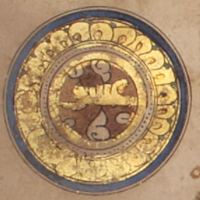- History of Art, Qur'anic Studies, Medieval Islamic History, Islamic Art, Islamic Calligraphy, Early and Medieval Islamic Art and Architecture, and 44 moreIslamic art history, Codicology, Rare Books and Manuscripts, Manuscripts, Arabic Manuscripts, Islamic Manuscripts, Kalam (Islamic Theology), Medieval Syria, Twelver Shi'ism, Histori of Imami Shiism, History of Arts, Islamic Studies, Mysticism, Religion, Sufism, Arabic Literature, Medieval Islam, Islamic Mysticism, Abbasid Intellectual History, Islamic' Architecture, Islamic Archaeology, Museum Studies, Book and Paper Conservation, Manuscript Studies, Quranic Studies, Iranian Art History, Islamic manuscripts illumination, Calligraphy in Islamic Architecture, - Islamic ornaments (Architecture), Architecture and Islamic patterns, Islamic ornaments, Turco-Iranian World, Arabic Epigraphy, Islamic Bookbinding, Art, Miniature Painting, Islamic Codicology, Persian Architecture, Islamic and Middle Eastern studies, Persian Bookbinding, Persian Art, Shahnameh, Islamic manuscript, Islamic Book Arts, and Codicology of Qur'anedit
ipsissima verba de Dieu pour les musulmans, est aujourd'hui un texte qui continue à être mémorisé, écrit (dans certaines régions du monde) et récité. Au début de l'islam, le texte coranique s'est transmis par voie orale. Bien que les
Research Interests:
After capturing the city of Mosul in December 2014, the so-called Islamic State in Iraq and Syria (ISIS) burned the university library destroying hundreds of thousands of books and manuscripts. The collection included Qur’ans among which... more
After capturing the city of Mosul in December 2014, the so-called Islamic State in Iraq and Syria (ISIS) burned the university library destroying hundreds of thousands of books and manuscripts. The collection included Qur’ans among which is a 9th century Qur’an. Like other episodes of our times, this performance reflects a certain engagement with the Qur’an that revives historically rooted debates related to the materiality of scripture. The relation of the sacred text to its material form has always been shaped by the ways in which people have dealt with the text's physical manifestations. Here specifically, it can be traced back to a theological framework that the talk will explore. If burning the Qur’an meant extracting sacrality out of the manuscript, the act certainly recalls the formation of a secular sphere in the museum context. A form of dematerialisation, the act also resonates with contemporary moments in which the sacredness of an object is transposed onto different realms and in which the meanings of artworks are negotiated, in and beyond Islamic communities.
Research Interests:
The so-called ‘Sulayhid Qur’an’ was copied in 417/1026 by Hussein b. Abdallah as the colophon at the end of its second volume informs us. Decades later, illuminated pages were added to its first volume with inscriptions stating it was... more
The so-called ‘Sulayhid Qur’an’ was copied in 417/1026 by Hussein b. Abdallah as the colophon at the end of its second volume informs us. Decades later, illuminated pages were added to its first volume with inscriptions stating it was ordered by the ruler of the Sulayhid dynasty in Yemen for the Fatimid caliph al-Mustansir (r. 427/1036-487/1094). As it reflected royal patronage, the Qur’an entered the sphere of diplomatic exchange offering legitimacy to ʿAlī b. Muḥammad al-Ṣulayḥī who had started propagating the daʿwa (summon) in Yemen and who ruled from 439/1047 on behalf of the Fatimids until his murder in 459/1066. One of the earliest Qur’ans to be copied in Round Style script on paper, it becomes an important testimony that survives from both dynasties’ Qur’anic production. Its decoration resonates with its Yemeni architectural surrounding, and highlights transregional trends across the Red Sea that connected Ethiopia to Yemen and Cairo. While its study unfolds stories of connections and belonging within and beyond a short-lived dynasty in which a women rose to a position of political prominence, the ‘Sulayhid Qur’an’ reveals the various stages in the life of a Qur’an, from the ways in which it was copied and illuminated to how it was appropriated and dispersed.
Research Interests:
Research Interests:
This article presents a description and analysis of a Persian translation and commentary of the Qurʾān, entitledTafsīr-i munīr, by Abū Naṣr al-Ḥaddādī (d. after 400/1009), the earliest exegetical work in Persian whose author can be... more
This article presents a description and analysis of a Persian translation and commentary of the Qurʾān, entitledTafsīr-i munīr, by Abū Naṣr al-Ḥaddādī (d. after 400/1009), the earliest exegetical work in Persian whose author can be identified. A manuscript of this multivolume work housed in the Topkapı Palace Museum of Istanbul offers an important historical testament to the calligraphic development of Persian exegetical writing and the manners in which scholars and authorities sought creative ways to visually balance the sacred Arabic text of the Qurʾān with vernacular exegetic material. The manuscript also reveals a good deal about Qurʾānic book art, as well as the development of Persian commentaries and translations, thus offering further insight into the history of the Qurʾān across the frontiers of Central Asia and Khurasan.
